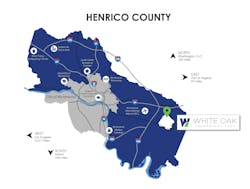Henrico County, Virginia Moves To Slow Data Center Growth
As the ongoing battle in Virginia to control data center growth continues, the most recent major change has taken place not in northern Virginia’s Loudoun County, the data center capitol of the universe, but in Henrico County, a region in the center of the state that surrounds the capitol of Richmond.
As of January 10, 2025, all data center construction will require a provisional use permit (PUP). A PUP is now required for any new hyperscale data center throughout the county, including in the White Oak Technology Park. Previously, large facilities within certain industrial or office zones could proceed without board-level approval, this being one of the major attractions of the White Oak Technology Park.
Henrico supervisors intend to contain data center expansion outside designated industrial zones, driven by concerns over unchecked energy use, noise, aesthetics, and resident objections.
As Varina District Supervisor Tyrone Nelson owned up to, both he and many of his compatriots on the board of supervisors in the county underestimated the broader implications when initially approving large-scale facilities. Quoted on the website richmondbizsense.com, he said, on his previous votes to support projects such as Meta’s data center in 2017 and the recent QTS data center expansion:
I didn’t understand everything that went with data centers. I didn’t. But I was excited that they were coming to our community in 2017. I own that, and I own voting last year for the rezoning of the property that QTS purchased.
Public Review Now Required for All New Projects: No More By-Right Development for Data Centers
Approval of a PUP must now undergo public hearings before both the Planning Commission and Board of Supervisors. There is no longer any by-right development possible, with Nelson stating that the data center industry moving out of the previously defined technology park was a motivation for him to reconsider his previous votes, with a concern that data centers would start popping up all over the county where existing industrial uses had previously been approved.
The board discussed the possibility of also requiring the inclusion of a residential advisory board in the approval process, but as of the meeting on the 10th had not moved forward on that proposal.
What they have done is require significantly stricter site requirements to be considered for the PUP:
· A 500-foot tree buffer between data centers and residential neighborhoods.
· Limitations / restrictions on when backup generators may be tested.
· Mandatory screening/enclosure of noise-generating equipment and closed-loop water-cooling systems.
· Utility readiness, visual buffering, and community impact are formal Comprehensive Plan goals.
These new requirements apply retroactively, but only to projects that have been rezoned but have not yet received final site plan approval or begun construction. County officials indicated that previously approved and permitted projects already under development may not be subject to all new conditions, depending on their stage in the review pipeline.
Existing Data Center Operators Have Yet to Comment
As we have previously reported, Iron Mountains, QTS, and DC Blox have significant expansion plans in place in Henrico County. In May of 2024 the county approved a rezoning request for 622 acres to create a data center campus, White Oak Technology Park II, which at that time was expected to have an additional 13 data centers constructed.
Northern Virginia (including Loudoun, Fairfax, and Prince William counties) has begun requiring special exceptions or conditional use approvals for large data centers, including mandatory noise impact studies, so far on a case by case basis. But overall, Virginia still lacks formal statewide legislation specifically regulating data center location, siting, noise, water usage, or energy impact.
Local communities are increasingly pushing back over noise, water, aesthetics, and long-term sustainability, which would indicate a need for more balanced regulation, but Virginia still lacks formal statewide legislation specifically regulating data center location, siting, noise, water usage, or energy impact. Partially due to the lack of statewide controls and the deep understanding of all of the related issues with data center development, some regions have backed away from rapid data center expansions or created special development locations with very strict regulations.
Statewide, numerous bills proposed in recent General Assembly sessions, including requirements for site impact assessments, utility certificate filings, and mandatory transparency of environmental data, have been defeated or vetoed.
As of publication, none of the data center developers affected by the new PUP requirements have publicly issued any statements.
A Cautionary Signal for a Maturing Industry
Henrico County’s regulatory pivot is not an isolated moment; it’s part of a growing pattern across high-growth data center markets. As hyperscale development surges to meet the demands of AI and cloud workloads, community concerns over land use, resource strain, and transparency are shaping a new phase in the industry’s evolution.
In 2025, Virginia remains the beating heart of digital infrastructure, but its local jurisdictions are increasingly stepping in where statewide policy has yet to reach. What’s happening in Henrico mirrors recent resistance in Prince William, Stafford, and Culpeper Counties, each reckoning with the externalities of relentless growth.
The message is clear. Where the industry once moved fast and under the radar, it must now build trust, engage communities, and justify its footprint with a more visible public benefit.
For developers and operators, the days of by-right entitlements and frictionless rezoning may be numbered. Local governments are demanding more deliberate, accountable expansion, with community buffers, noise control, and power planning embedded in the approval process.
Henrico’s new rules, particularly their retroactive nature, underscore how quickly the policy climate can shift, even in data center-friendly markets. The industry would be wise to view Henrico not as an outlier, but as an early signal of the deeper balancing act ahead, aligning scale and speed with stewardship and transparency. In the age of AI, the challenge isn't merely whether data centers can be built, but whether and how they can earn lasting permission to stay.
At its June 10 regular meeting, the Henrico County Board of Supervisors approved the new regulations for data centers. Below, Varina District Supervisor Tyrone Nelson and County Attorney Andrew Newby explain the more restrictive regulations and how they will impact the review of future data center projects in the county.
At Data Center Frontier, we talk the industry talk and walk the industry walk. In that spirit, DCF Staff members may occasionally use AI tools to assist with content. Elements of this article were created with help from OpenAI's GPT4.
Keep pace with the fast-moving world of data centers and cloud computing by connecting with Data Center Frontier on LinkedIn, following us on X/Twitter and Facebook, as well as on BlueSky, and signing up for our weekly newsletters using the form below.
About the Author

David Chernicoff
Matt Vincent
A B2B technology journalist and editor with more than two decades of experience, Matt Vincent is Editor in Chief of Data Center Frontier.



